Effect of Magnesium Fertilization Systems on Grain Yield Formation by Winter Wheat (Triticum aestivum L.) during the Grain-Filling Period
Abstract
:1. Introduction
2. Materials and Methods
2.1. Experimental Site
2.2. Weather Conditions
2.3. Experimental Design
- (1)
- Soil-applied magnesium (Mgs): 0, 25, 50 kg Mg ha−1.
- (2)
- Foliar-applied magnesium (Mgf):
- a.
- Without application.
- b.
- Applied at the BBCH 30 stage (I).
- c.
- Applied at the BBCH 49/50 stage (II),
- d.
- Double-stage application (I + II).
2.4. Plant Material Sampling and Analysis
2.5. Calculated Parameters
- Dry matter remobilization quota (REQ):
- a.
- REQ79 = TB58 – TBv79, t ha−1.
- b.
- REQ79–89 = TBv79 – TBv89, t ha−1.
- c.
- REQ89 = TB58 – TBv89, t ha−1.
- Dry matter remobilization efficiency (ReE):
- a.
- ReE79 = REQ79/TB58, %.
- b.
- ReE79–89 = REQ79/TBv79, %.
- c.
- ReE89 = REQ89/TB58, %.
- Contribution of remobilized dry matter in the grain yield (ReG):
- a.
- ReG79 = REQ79/GY79, %.
- b.
- ReG79–89 = REQ79/ΔGT79–89, %.
- c.
- ReG79 = REQ89/GY89, %.
- Current photosynthesis (CP):
- a.
- CP79 = TB79 – TB58, t ha−1.
- b.
- CP79–89 = TB89 – TB79, t ha−1.
- c.
- CP89 = TB89 – TB58, t ha−1.
- Efficiency of current photosynthesis (CPE):
- a.
- CPE79/TB58, %.
- b.
- CPE79–89/TB79, %.
- c.
- CPE89/TB58, %.
- Contribution of current photosynthesis to the grain yield (CPG):
- a.
- CPG79 = CP79/GY79, %.
- b.
- CPG79–89 = CP79/ΔGY79, %.
- c.
- CPG79 = CP79/GY89, %.
- TB58—dry matter (leaves + stem + ear) yield of wheat at BBCH 58, t ha−1 DW.
- TBv79—dry matter (leaves + stem + chaffs) yield of wheat at BBCH 79, t ha−1 DW.
- GY79—dry matter yield of grain at BBCH 79, t ha−1 DW.
- TB79—total dry matter (leaves + stem + chaffs + grain) yield of wheat at BBCH 79, t ha−1 DW.
- TBv89—dry matter (leaves + stem + chaffs) yield of wheat at BBCH 79, t ha−1 DW.
- ΔGY89—dry matter yield of grain at BBCH 79–89, t ha−1 DW.
- GY89—dry matter yield of grain at BBCH 79, t ha−1 DW.
- TB89—total dry matter (leaves + stem + chaffs + grain) yield of wheat at BBCH 79, t ha−1 DW.
2.6. Statistical Analysis
3. Results
3.1. Grain Yield and Yield Structure
3.2. Wheat Biomass Structure during the Grain-Filling Period
3.3. Indices of Dry Matter Management by Wheat during the Grain-Filling Period
4. Discussion
4.1. Magnesium Fertilization Systems and Grain Yield Development during the Grain-Filling Period
- a.
- Very high GD, which increased due to Mg application from 24,000 to 30,000 grains per m2.
- b.
- Favorable growth conditions throughout the whole wheat vegetation.
4.2. Magnesium Fertilization Systems and Sink–Source Relationships during the Grain-Filling Period
4.3. Magnesium Fertilization Systems and Indices of Dry Matter Management during the Grain-Filling Phase
- (1)
- The size of the sink, expressed as the ED, GR, and finally by GD.
- (2)
- Weather conditions in the periods responsible for the formation of wheat yield components.
- (3)
- Phases of grain growth.
5. Conclusions
Author Contributions
Funding
Institutional Review Board Statement
Informed Consent Statement
Data Availability Statement
Conflicts of Interest
Appendix A
| Trait | ST58 | EA58 | LE79 | ST79 | CH79 | GY79 | LE89 | ST89 | CH89 | GY89 | ED | GR | GD | TGW |
|---|---|---|---|---|---|---|---|---|---|---|---|---|---|---|
| LE58 | 0.89 *** | 0.66 *** | 0.77 *** | −0.35 * | 0.35 * | 0.55 *** | 0.79 *** | 0.48 ** | 0.27 | 0.91 *** | 0.70 *** | 0.42 * | 0.84 *** | −0.81 *** |
| ST58 | 1.00 | 0.70 *** | 0.67 *** | −0.32 | 0.25 | 0.61 *** | 0.76 *** | 0.56 *** | 0.15 | 0.83 *** | 0.74 *** | 0.30 | 0.77 *** | −0.80 *** |
| EA58 | 1.00 | 0.61 *** | 0.17 | −0.24 | 0.77 *** | 0.70 *** | 0.75 *** | −0.38 * | 0.47 ** | 0.76 *** | −0.26 | 0.34 * | −0.69 *** | |
| LE79 | 1.00 | −0.08 | 0.29 | 0.70 *** | 0.86 *** | 0.63 *** | 0.06 | 0.79 *** | 0.73 *** | 0.21 | 0.70 *** | −0.78 *** | ||
| ST79 | 1.00 | −0.33 | 0.18 | −0.15 | 0.15 | −0.42 * | −0.41 * | −0.12 | −0.51 ** | −0.49 ** | 0.24 | |||
| Ch79 | 1.00 | −0.17 | 0.14 | −0.22 | 0.72 *** | 0.49 ** | −0.04 | 0.72 *** | 0.55 ** | −0.11 | ||||
| GY79 | 1.00 | 0.81 *** | 0.85 *** | −0.41 * | 0.46 ** | 0.83 *** | −0.35 * | 0.32 | −0.73 *** | |||||
| LE89 | 1.00 | 0.78 *** | −0.09 | 0.77 *** | 0.88 *** | 0.07 | 0.70 *** | −0.90 *** | ||||||
| ST89 | 1.00 | −0.42 * | 0.41 * | 0.86 *** | −0.41 * | 0.30 | −0.72 *** | |||||||
| Ch89 | 1.00 | 0.42 * | −0.19 | 0.85 *** | 0.55 *** | 0.05 | ||||||||
| GY89 | 1.00 | 0.68 *** | 0.58 *** | 0.95 *** | −0.79 *** | |||||||||
| ED | 1.00 | −0.14 | 0.62 *** | −0.87 *** | ||||||||||
| GR | 1.00 | 0.69 *** | −0.10 | |||||||||||
| GD | 1.00 | −0.71 *** |
| Trait | T79v | GY79 | T79 | Tv89 | GY89 | REQ89 | RE89 | Re89Z | CP89 | CPC89 | CPZ89 | ED | GR | GD | TGW |
|---|---|---|---|---|---|---|---|---|---|---|---|---|---|---|---|
| T58 | 0.24 | 0.70 *** | 0.56 *** | 0.79 *** | 0.80 *** | 0.89 *** | 0.82 *** | 0.85 *** | −0.51 ** | −0.90 *** | −0.85 *** | 0.80 *** | 0.16 | 0.70 *** | −0.84 *** |
| T79v | 1.00 | 0.43 ** | 0.86 *** | 0.37 * | 0.23 | 0.09 | 0.06 | 0.07 | 0.08 | −0.13 | −0.07 | 0.24 | −0.05 | 0.14 | −0.26 |
| GY79 | 1.00 | 0.84 *** | 0.80 *** | 0.46 ** | 0.45 ** | 0.36 * | 0.44 ** | −0.20 | −0.57 *** | −0.44 | 0.83 *** | −0.35 * | 0.32 | −0.73 *** | |
| T79 | 1.00 | 0.70 *** | 0.40 * | 0.31 | 0.25 | 0.30 | −0.07 | −0.41 * | −0.30 | 0.63 *** | −0.23 | 0.27 | −0.56 *** | ||
| Tv89 | 1.00 | 0.70 *** | 0.42 * | 0.30 | 0.36 * | 0.04 | −0.49 ** | −0.36 * | 0.91 *** | −0.05 | 0.63 *** | −0.84 *** | |||
| GY89 | 1.00 | 0.66 *** | 0.60 *** | 0.54 ** | −0.02 | −0.54 ** | −0.54 ** | 0.68 *** | 0.58 *** | 0.95 *** | −0.79 *** | ||||
| REQ89 | 1.00 | 0.98 *** | 0.99 *** | −0.77 *** | −0.96 *** | −0.99 *** | 0.51 ** | 0.27 | 0.57 *** | −0.61 *** | |||||
| RE89 | 1.00 | 0.98 *** | −0.79 *** | −0.94 *** | −0.98 *** | 0.43 * | 0.28 | 0.52 ** | −0.53 ** | ||||||
| Re89Z | 1.00 | −0.85 *** | −0.98 *** | −1.00 *** | 0.48 ** | 0.16 | 0.46 ** | −0.56 ** | |||||||
| CP89 | 1.00 | 0.81 *** | 0.85 *** | −0.11 | 0.13 | 0.05 | 0.14 | ||||||||
| CPC89 | 1.00 | 0.98 *** | −0.59 *** | −0.03 | −0.44 ** | 0.63 *** | |||||||||
| CPZ89 | 1.00 | −0.48 ** | −0.16 | −0.45 ** | 0.55 ** | ||||||||||
| ED | 1.00 | −0.14 | 0.62 *** | −0.87 *** | |||||||||||
| GR | 1.00 | 0.69 *** | −0.10 | ||||||||||||
| GD | 1.00 | −0.71 *** |
| Trait | GY89 | dGY89 | Tv79 | Tv89 | REQ d79 | ReE d79 | ReG d79 | CP d79 | CPE d79 | CPG d79 | REQ d89 | RE d89 | ReG d89 | CP d89 | CPC d89 | CPG d89 | ED | GR | GD | TGW |
|---|---|---|---|---|---|---|---|---|---|---|---|---|---|---|---|---|---|---|---|---|
| GY79 | 0.46 ** | −0.40 ** | 0.43 ** | 0.81 *** | 0.56 *** | 0.59 *** | 0.55 *** | −0.22 | −0.35 * | −0.55 ** | −0.49 ** | −0.55 *** | −0.55 ** | 0.54 ** | 0.39 * | 0.55 ** | 0.83 *** | 0.35 * | 0.32 | −0.73 *** |
| GY89 | 1.00 | 0.63 *** | 0.23 | 0.70 *** | 0.73 *** | 0.74 *** | 0.75 *** | −0.66 *** | −0.76 *** | −0.75 *** | −0.53 ** | −0.56 *** | −0.63 *** | 0.86 *** | 0.73 *** | 0.64 *** | 0.68 *** | 0.58 *** | 0.95 *** | −0.79 *** |
| dGY89 | 1.00 | −0.14 | 0.02 | 0.26 | 0.25 | 0.30 | −0.49 ** | −0.48 ** | −0.30 | −0.12 | −0.10 | −0.18 | 0.41 * | 0.42 * | 0.18 | −0.02 | 0.90 *** | 0.70 *** | −0.17 | |
| T79v | 1.00 | 0.37 * | −0.13 | −0.12 | −0.13 | 0.34 * | 0.07 | 0.13 | 0.36 * | 0.27 | 0.28 | −0.10 | −0.04 * | −0.28 | 0.24 | −0.05 | 0.14 | −0.22 | ||
| Tv89 | 1.00 | 0.66 *** | 0.69 *** | 0.67 *** | −0.43 ** | −0.55 ** | −0.67 *** | −0.73 *** | −0.79 *** | −0.78 *** | 0.82 *** | 0.66 *** | 0.78 *** | 0.91 *** | −0.05 | 0.63 *** | −0.84 *** | |||
| REQ79 | 1.00 | 0.99 *** | 1.00 *** | −0.93 *** | −0.95 *** | −1.00 *** | −0.76 *** | −0.76 *** | −0.81 *** | 0.86 *** | 0.82 *** | 0.81 *** | 0.73 *** | 0.18 | 0.67 *** | −0.78 *** | ||||
| RE79 | 1.00 | 0.99 ** | −0.90 *** | −0.92 *** | −0.99 *** | −0.78 *** | −0.78 *** | −0.84 *** | 0.87 *** | 0.85 *** | 0.84 *** | 0.77 *** | 0.16 | 0.67 *** | −0.80 *** | |||||
| ReE79 | 1.00 | −0.94 *** | −0.95 *** | 1.00 | −0.76 *** | −0.76 *** | −0.81 *** | 0.86 *** | 0.84 *** | 0.81 *** | 0.72 *** | 0.22 | 0.69 *** | −0.78 *** | ||||||
| CP79 | 1.00 | 0.96 *** | 0.94 *** | 0.68 *** | 0.65 *** | 0.71 *** | −0.76 *** | −0.80 *** | −0.71 ** | −0.50 ** | −0.37 * | −0.65 *** | 0.59 *** | |||||||
| CPE79 | 1.00 | 0.95 *** | 0.60 *** | 0.60 *** | 0.66 *** | −0.77 *** | −0.73 *** | −0.66 *** | −0.66 *** | −0.31 | −0.72 *** | 0.74 *** | ||||||||
| CP9 | 1.00 | 0.76 *** | 0.76 *** | 0.81 *** | −0.86 *** | −0.84 *** | −0.81 *** | −0.72 *** | −0.22 | −0.69 *** | 0.78 *** | |||||||||
| REQ89 | 1.00 | 0.99 *** | 0.99 *** | −0.90 *** | −0.93 *** | −0.99 *** | −0.74 *** | 0.01 | −0.53 ** | 0.68 *** | ||||||||||
| RE89 | 1.00 | 0.99 *** | −0.90 *** | −0.92 *** | −0.99 *** | −0.79 *** | 0.03 | −0.56 *** | 0.73 *** | |||||||||||
| Re89Z | 1.00 | −0.94 *** | −0.95 *** | −1.00 | 0.01 | −0.11 | −0.07 | 0.03 | ||||||||||||
| CP89 | 1.00 | 0.96 | 0.94 | 0.52 ** | 0.54 ** | 0.80 *** | −0.60 *** | |||||||||||||
| CPC89 | 1.00 | 0.95 | 0.57 *** | 0.49 ** | 0.80 *** | −0.64 *** | ||||||||||||||
| CPZ89 | 1.00 | −0.01 | 0.11 | 0.07 | −0.03 | |||||||||||||||
| ED | 1.00 | 0.14 | 0.62 *** | −0.10 | ||||||||||||||||
| Gr | 1.00 | 0.69 *** | −0.10 | |||||||||||||||||
| GD | 1.00 | −0.71*** |
References
- Hunter, M.C.; Smith, R.G.; Schipanski, M.E.; Atwood, L.W.; Mortensen, D.A. Agriculture in 2050: Recalibrating targets for sustainable intensification. BioScience 2017, 67, 386–391. [Google Scholar] [CrossRef] [Green Version]
- Ray, D.K.; Ramankutty, N.; Mueller, N.D.; West, P.C.; Foley, J.A. Recent patterns of crop yield growth and stagnation. Nat. Commun. 2012, 3, 1293. [Google Scholar] [CrossRef] [PubMed] [Green Version]
- Shewry, P.R.; Hey, S.J. The contribution of wheat to human diet and health. Food Energy Sec. 2015, 493, 178–202. [Google Scholar] [CrossRef]
- Available online: https://www.guinnessworldrecords.com/world–records/highest–wheat–yield (accessed on 18 November 2021).
- Supit, I.; van Diepen, C.A.; de Wit, A.J.W.; Kabat, P.; Baruth, B.; Ludwig, F. Recent changes in the climatic yield potential of various crops in Europe. Agric. Syst. 2010, 103, 683–694. [Google Scholar] [CrossRef]
- FAOSTAT. 2021. Available online: https://www.fao.org/statistics (accessed on 18 November 2021).
- Klepper, B.; Rickman, R.W.; Waldman, S.; Chevalier, P. The physiological life cycle of wheat: Its use in breeding and crop management. Euphytica 1998, 100, 341–347. [Google Scholar] [CrossRef]
- Rickman, R.W.; Waldman, S.E.; Klepper, B. MODWht3: A development driven wheat growth simulation. Agron. J. 1996, 88, 176–185. [Google Scholar] [CrossRef]
- Fisher, R.A. Wheat physiology: A review of recent developments. Crop Pasture Sci. 2011, 62, 95–114. [Google Scholar] [CrossRef] [Green Version]
- Serrago, R.A.; Alzueta, I.; Savin, R.; Slafer, G.A. Understanding grain yield responses to source–sink ratios during grain filling in wheat and barley under constraining environments. Field Crop. Res. 2013, 150, 42–51. [Google Scholar] [CrossRef] [Green Version]
- Gaju, O.; Allard, V.; Martre, P.; Le Gouis, J.; Moreau, D.; Bogard, M.; Hubbart, S.; Foulkes, M.J. Nitrogen partitioning and remobilization in relation to leaf senescence, grain yield and grain nitrogen concentration in wheat cultivars. Field Crop. Res. 2014, 155, 213–223. [Google Scholar] [CrossRef]
- Sadras, V.O.; Lawson, C. Genetic gain in yield and associated changes in phenotype, trait plasticity and competitive ability of South Australian wheat varieties released between 1958 and 2007. Crop Pasture Sci. 2011, 62, 533–549. [Google Scholar] [CrossRef]
- Slafer, G.A.; Elia, M.; Savin, R.; Garcia, G.A.; Terrile, I.I.; Ferrante, A.; Miralles, D.J.; González, F.G. Fruiting efficiency: An alternative trait to further rise in wheat yield. Food Energy Sec. 2015, 4, 92–109. [Google Scholar] [CrossRef]
- Kong, L.G.; Xie, Y.; Hu, L.; Feng, B.; Li, S.D. Remobilization of vegetative nitrogen to developing grain in wheat (Triticum aestivum L.). Field Crop. Res. 2016, 196, 134–144. [Google Scholar] [CrossRef]
- Farooq, M.; Hussainf, M.; Siddique, K.H.M. Drought stress in wheat during flowering and grain–filling periods. Crit. Rev. Plant Sci. 2014, 33, 331–349. [Google Scholar] [CrossRef]
- Duan, J.; Wu, Y.; Zhou, Y.; Ren, X.; Shao, Y.; Feng, W.; Zhu, Y.; Wang, Y.; Guo, T. Grain number response to pre–anthesis dry matter and nitrogen in improving wheat yield in the Huang–Huai Plain. Sci. Rep. 2018, 8, 7126. [Google Scholar] [CrossRef] [PubMed]
- Sinclair, T.R.; Jamieson, P.D. Yield and grain number of wheat: A correlation or causal relationship? Authors’ response to „The importance of grain or kernel number in wheta: A replair to Sinclair and Jamieson by R.A. Fisher. Field Crop. Res. 2008, 105, 22–26. [Google Scholar] [CrossRef]
- Xie, Q.; Mayes, S.; Sparkes, D.L. Preanthesis biomass accumulation and plant organs defines yield components in wheat. Eur. J. Agron. 2016, 81, 15–26. [Google Scholar] [CrossRef]
- Blum, A. Improving wheat grain filling under stress by stem reserve mobilization. Euphytica 1998, 100, 77–83. [Google Scholar] [CrossRef]
- Masoni, A.; Ercoli, L.; Mariotti, M.; Arduini, I. Post–anthesis accumulation and remobilization of dry matter, nitrogen and phosphorus in durum wheat as affected by soil type. Eur. J. Agron. 2007, 26, 179–186. [Google Scholar] [CrossRef]
- Ehdaie, B.; Alloush, G.; Madore, M.; Waines, J. Genotypic variation for stem reserves and mobilization in wheat: II.Postanthesis changes in internode water–soluble carbohydrates. Crop Sci. 2006, 46, 2093–2103. [Google Scholar] [CrossRef]
- Ma, J.; Huang, G.B.; Yang, D.L.; Chai, Q. Dry matter remobilization and compensatory effects in various internodes of spring wheat under water stress. Crop Sci. 2014, 53, 331–339. [Google Scholar] [CrossRef]
- Zhang, J.; Chen, W.; Dell, B.; Vergauwen, R.; Zhang, X.; Mayer, J.E.; Van den Ende, W. Wheat genotypic variation in dynamic fluxes of WSC components in different stem segments under drought during grain filling. Front. Plant Sci. 2015, 6, 624. [Google Scholar] [CrossRef] [Green Version]
- Liu, E.K.; Mei, X.R.; Yan, C.R.; Gong, D.Z.; Zhang, Y.Q. Effects of water stress on phytosynteetic characteristics, dry matter translocation and WUE in two winter wheat genotypes. Agric. Water Manag. 2016, 167, 75–85. [Google Scholar] [CrossRef]
- Grafton, R.Q.; Williams, J.; Jiang, Q. Food and water gaps to 2050: Preliminary results from the global food and water systems (GFWS) platform. Food Sec. 2015, 7, 209–220. [Google Scholar] [CrossRef] [Green Version]
- Liu, J.; Williams, J.R.; Zehnder, A.J.B.; Yang, H. GEPIC—modelling wheat yield and crop water productivity with high resolution on a global scale. Agric. Syst. 2007, 94, 478–493. [Google Scholar] [CrossRef]
- Johnston, A.M.; Bruulsema, T.W. 4R nutrient stewardship for improved nutrient use efficiency. Procedia Eng. 2014, 83, 365–370. [Google Scholar] [CrossRef] [Green Version]
- Ma, G.; Liu, W.; Li, S.; Zhang, P.; Wang, C.; Lu, H.; Wang, L.; Xie, Y.; Ma, D.; Kang, G. Determining the optimal N input to improve grain yield and Quality in winter wheat with reduced apparent N loss in the North China. Front. Plant Sci. 2019, 10, 181. [Google Scholar] [CrossRef] [Green Version]
- Kostić, M.M.; Tagarakis, A.C.; Ljubičić, N.; Blagojević, D.; Radulović, M.; Ivoševic, B.; Rakić, D. The Effect of N Fertilizer Application Timing on Wheat Yield on Chernozem Soil. Agronomy 2021, 11, 1413. [Google Scholar] [CrossRef]
- Schauberger, B.; Ben–Ari, T.; Makowski, D.; Kato, T.; Kato, H.; Ciais, P. Yield trends, variability and stagnation analysis of major crops in France over more than a century. Sci. Rep. 2018, 8, 16865. [Google Scholar] [CrossRef]
- Vargas, M.; Glaz, B.; Alvarado, G.; Pietragalla, J.; Morgounov, A.; Zelenskiy, Y.; Crossa, J. Analysis and Interpretation of Interactions in Agricultural Research. Agron. J. 2015, 107, 748–762. [Google Scholar] [CrossRef] [Green Version]
- Tabak, M.; Lepiarczyk, A.; Filipek–Mazur, B.; Lisowska, A. Efficiency of Nitrogen Fertilization of Winter Wheat Depending on Sulfur Fertilization. Agronomy 2020, 10, 1304. [Google Scholar] [CrossRef]
- Klikocka, H.; Marks, M.; Barczak, B.; Szostak, B.; Podleśna, A.; Podleśny, J. Response of spring wheat to NPK and S fertilization. The content and uptake of macronutrients and the value of ionic ratios. Open Chem. 2018, 16, 1059–1065. [Google Scholar] [CrossRef]
- Grzebisz, W. Crop response to magnesium fertilization as affected by nitrogen supply. Plant Soil 2013, 368, 23–39. [Google Scholar] [CrossRef]
- Wang, Z.; Hassan, M.U.; Nadeem, F.; Wu, L.; Zhang, F.; Li, X. Magnesium fertilization improves crop yield in most prodyuction systems: A meta–analysis. Front. Plant Sci. 2020, 10, 1727. [Google Scholar] [CrossRef] [Green Version]
- Kabała, C.; Charzyński, P.; Chodorowski, J.; Drewnik, M.; Glina, B.; Greinert, A.; Hulisz, P.; Jaknkowski, M.; Jonczak, J.; Łabaz, B.; et al. Polish Soil Classification: Principles, classification scheme and correlation. Soil Sci. Annu. 2019, 70, 71–97. [Google Scholar] [CrossRef] [Green Version]
- Meier, U. (Ed.) Growth stages of mono- and dicotyledonous plants. In BBCH Monograph, 4th ed.; Federal Biological Research Centre for Agriculture and Forestry, Julius Kuhn-Institut: Quedlinburg, Germany, 2018; p. 204. [Google Scholar]
- Papakosta, D.K.; Gagianas, A.A. Nitrogen and dry matter accumulation, remobilization, and losses for Mediterranean wheat during grain filling. Agron. J. 1991, 83, 864–870. [Google Scholar] [CrossRef]
- Lu, D.; Lu, F.; Pan, J.; Cui, Z.; Zou, C.; Chen, X.; He, M.; Wang, Z. The effects of cultivar and nitrogen management on wheat yield and nitrogen use efficiency in the North China Plain. Field Crop. Res. 2015, 171, 157–164. [Google Scholar] [CrossRef]
- Belete, F.; Dechassa, N.; Molla, A.; Tana, T. Effect of split application of different N rates on productivity and nitrogen use effciency of bread wheat (Triticum aestivum L.). Agric. Food Sec. 2018, 7, 92. [Google Scholar] [CrossRef]
- Grzebisz, W.; Diatta, J. Constrains and solutions to maintain soil productivity, a case study from Central Europe. In Soil Fertility Improvement and Integrated Nutrient Management—A Global Perspective; Whalen, J., Ed.; InTech: London, UK, 2012; pp. 159–183. [Google Scholar]
- Würschum, T.; Leiser, W.L.; Langner, S.M.; Tucker, M.R.; Longin, C.F.H. Phenotypic anf genetic analysis of spike and kernel characteristics in wheat reveals long-term genetic trends of grain yield components. Theor. Appl. Genet. 2018, 131, 2071–2084. [Google Scholar] [CrossRef]
- Hodgkinson, L.; Dodd, I.C.; Binley, A.; Ashton, R.W.; White, R.P.; Watts, C.W.; Whalley, W.R. Root growth in field grown winter wheat: Some effects of soil conditions, season and genotype. Eur. J. Agron. 2017, 91, 74–83. [Google Scholar] [CrossRef] [PubMed]
- Shearman, V.J.; Sylvester–Bradley, R.; Scott, R.K.; Foulkes, M.J. Physiological processes associated with wheat yield progress in the UK. Crop Sci. 2005, 45, 175–185. [Google Scholar]
- Fisher, R.A. The importance of grain or kernel number in wheat: A reply to Sinclair and Jamieson. Field Crop. Res. 2008, 105, 15–21. [Google Scholar] [CrossRef]
- Körner, C. Paradigm shift in plant growth control. Curr. Opin. Plant Biol. 2015, 25, 107–114. [Google Scholar] [CrossRef] [PubMed]
- Guo, Z.; Chen, D.; Schnurbusch, T. Plant and floret growth at distinct developmental stages during the stem elongation phase in wheat. Front. Plant Sci. 2018, 9, 330. [Google Scholar] [CrossRef] [PubMed] [Green Version]
- Bindraban, P.S.; Sayre, K.D.; Solismoya, E. Identifying factors that determine kernel number in wheat. Field Crop. Res. 1998, 58, 223–234. [Google Scholar] [CrossRef]
- Gebbing, T.; Schnyder, H. Pre–anthesis reserve utilization for protein and carbohydrate synthesis in grains of wheat. Plant Physiol. 1999, 121, 871–878. [Google Scholar] [CrossRef] [Green Version]
- Estrada-Campuzano, G.; Slafer, G.A.; Miralles, D.J. Differences in yield, biomass and their components between triticale and wheat grown under contrasting water and nitrogen environments. Field Crop. Res. 2012, 128, 167–179. [Google Scholar] [CrossRef]
- Van Herwaarden, A.F.; Farquhar, G.D.; Angus, J.F.; Richards, R.A.; Howe, G.N. ‘Haying-off’ the negative grain yield response of dryland wheat to nitrogen fertiliser. I. Biomass, grain yield, and water use. Aust. J. Agric. Res. 1998, 49, 1067–1081. [Google Scholar] [CrossRef]
- Schnyder, H. The role of carbohydrate storage and redistribution in the source–sink relations of wheat and barley during grain filling. A review. New Phytol. 1993, 123, 233–245. [Google Scholar] [CrossRef]
- Liang, X.; Liu, Y.; Chen, Y.; Adams, C. Late–season photosynthetic rate and senescence were associated with grain yield in winter wheat of diverse origin. J. Agron. Crop. Sci. 2018, 204, 1–12. [Google Scholar] [CrossRef]
- Acreche, M.M.; Slafer, G.A. Grain weight, radiation interception and use efficiency as affected by sink–strength in Mediterranean wheats released from 1940 to 2005. Field Crop. Res. 2009, 110, 98–105. [Google Scholar] [CrossRef]
- Tränkner, M.; Tavakol, E.; Jákli, B. Functioning of potassium and magnesium in photosynthesis, photosynthate translocation and photoprotection. Physiol. Plant. 2018, 163, 414–431. [Google Scholar] [CrossRef] [PubMed] [Green Version]
- Ceylan, Y.; Kutman, U.B.; Mengutay, M.; Cakmak, I. Magnesium application to growth medium and foliage affect the starch distribution, increase the grain size and improve the seed germination in wheat. Plant Soil 2016, 406, 145–156. [Google Scholar] [CrossRef]
- Popović, V.; Ljubičić, N.; Kostić, M.; Radulović, M.; Blagojević, D.; Ugrenović, V.; Popović, D.; Ivošević, B. Genotype × Environment Interaction for Wheat Yield Traits Suitable for Selection in Different Seed Priming Conditions. Plants 2020, 9, 1804. [Google Scholar] [CrossRef] [PubMed]
- Ljubičić, N.; Popović, V.; Ćirić, V.; Kostić, M.; Ivošević, B.; Popović, D.; Pandžić, M.; El Musafah, S.; Janković, S. Multivariate Interaction Analysis of Winter Wheat Grown in Environment of Limited Soil Conditions. Plants 2021, 10, 604. [Google Scholar] [CrossRef] [PubMed]
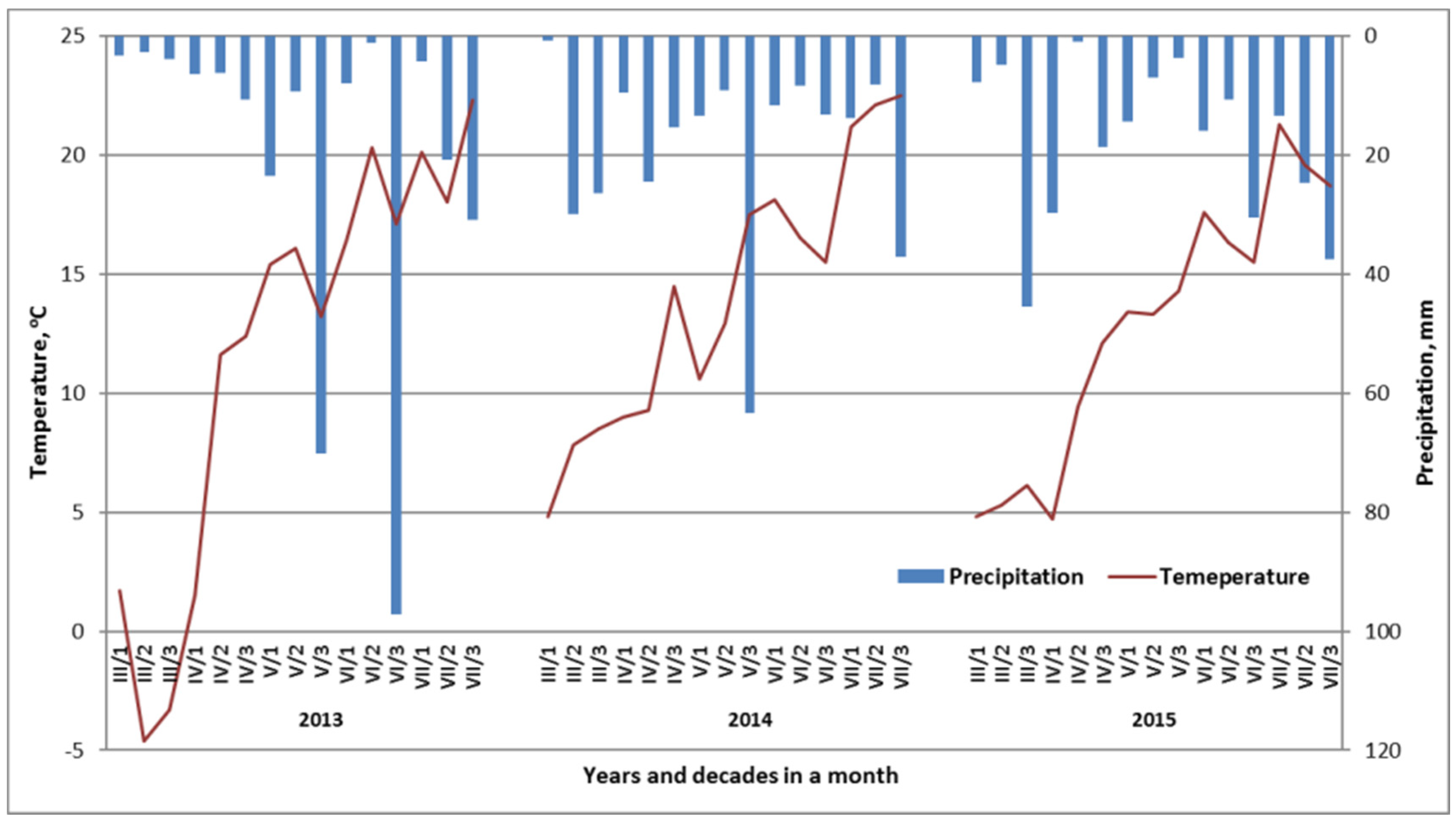

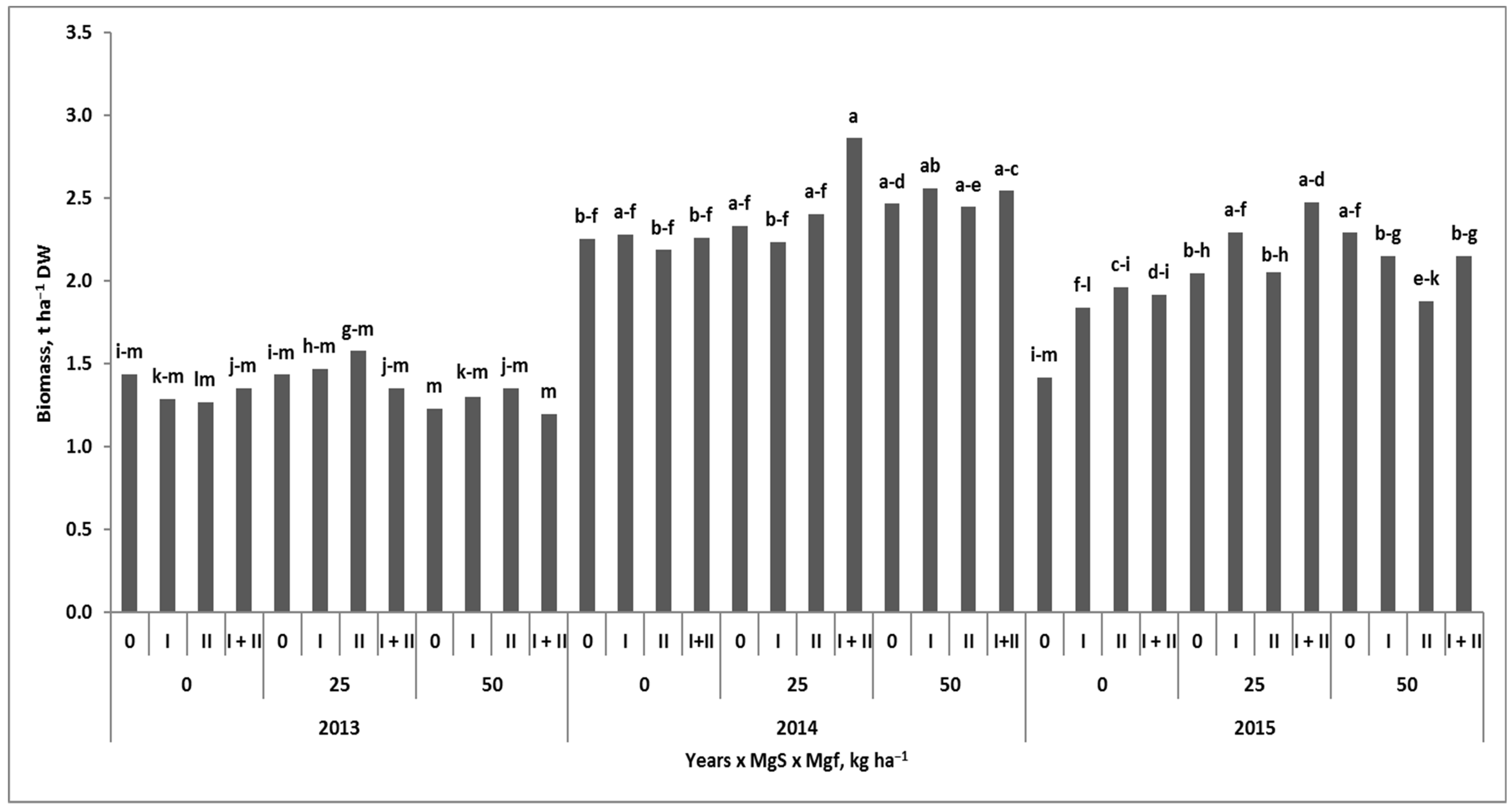

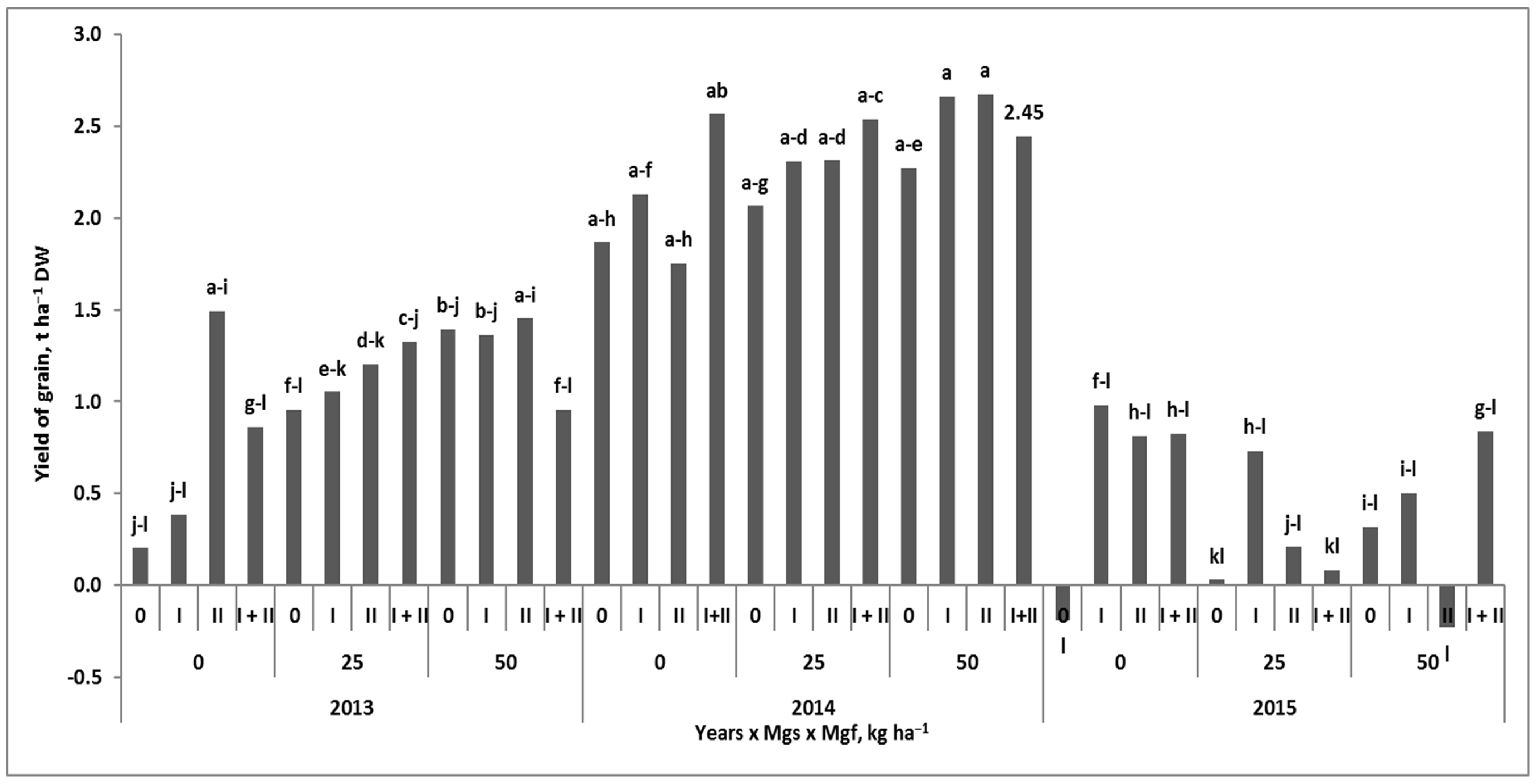
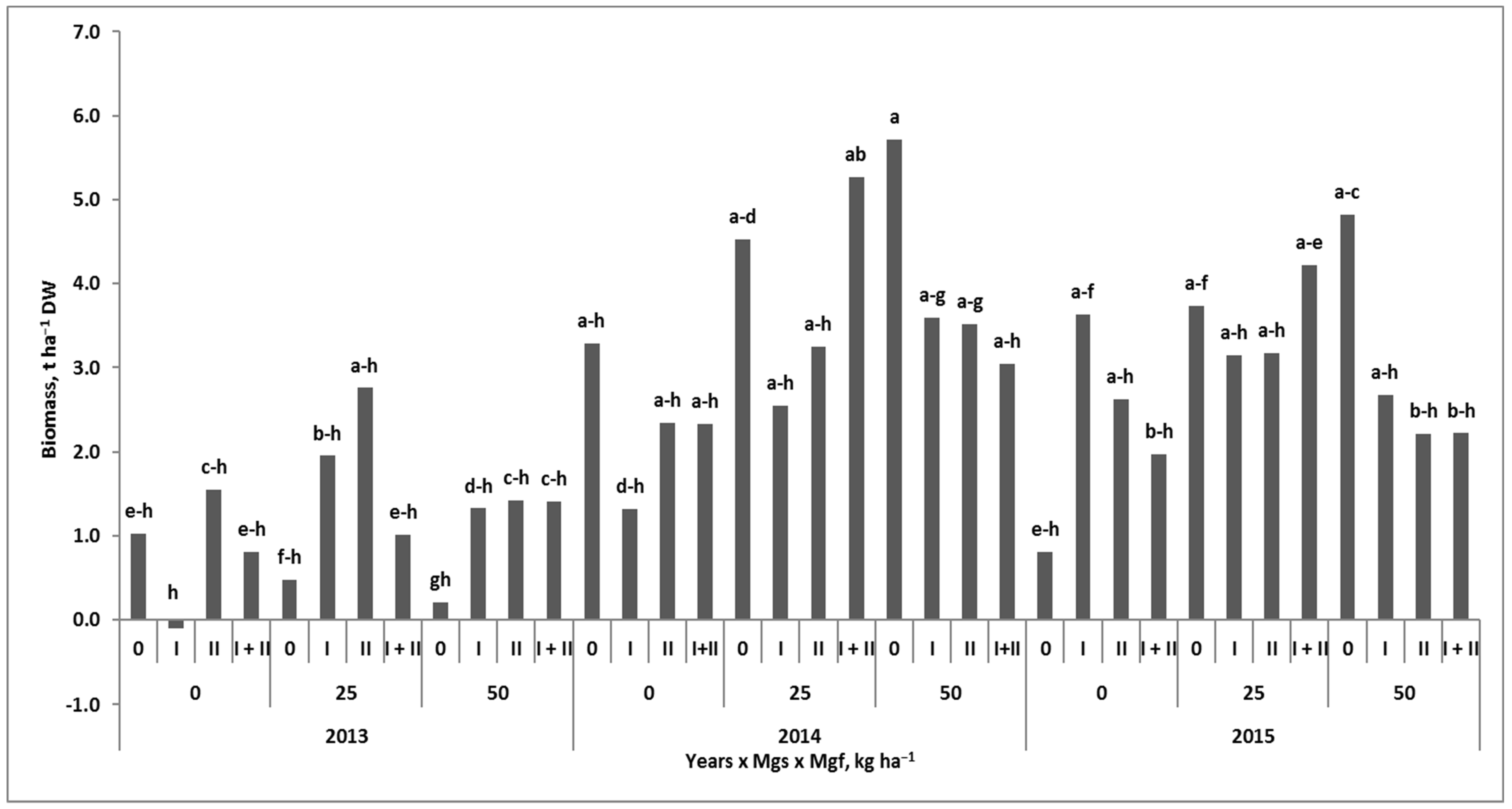
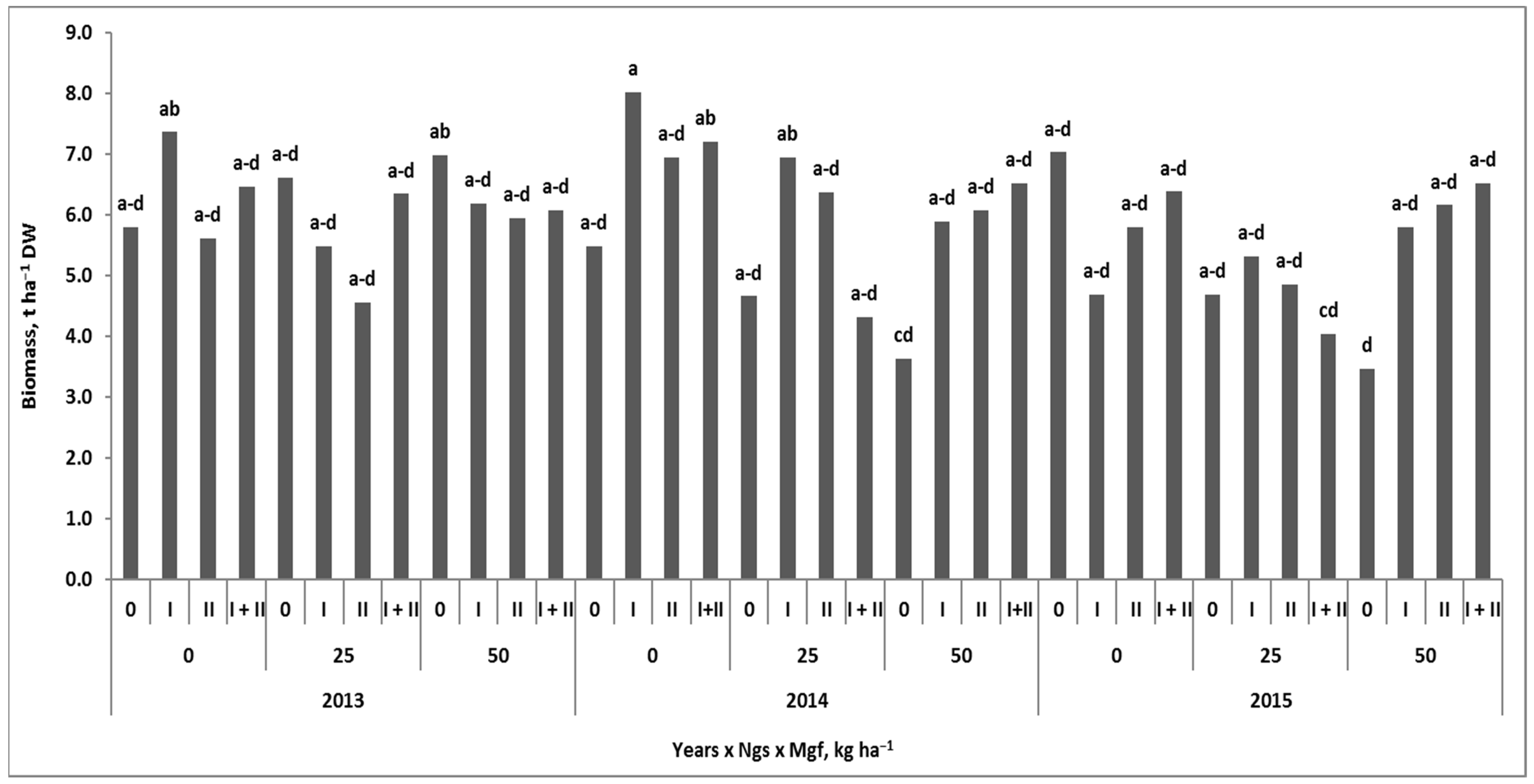
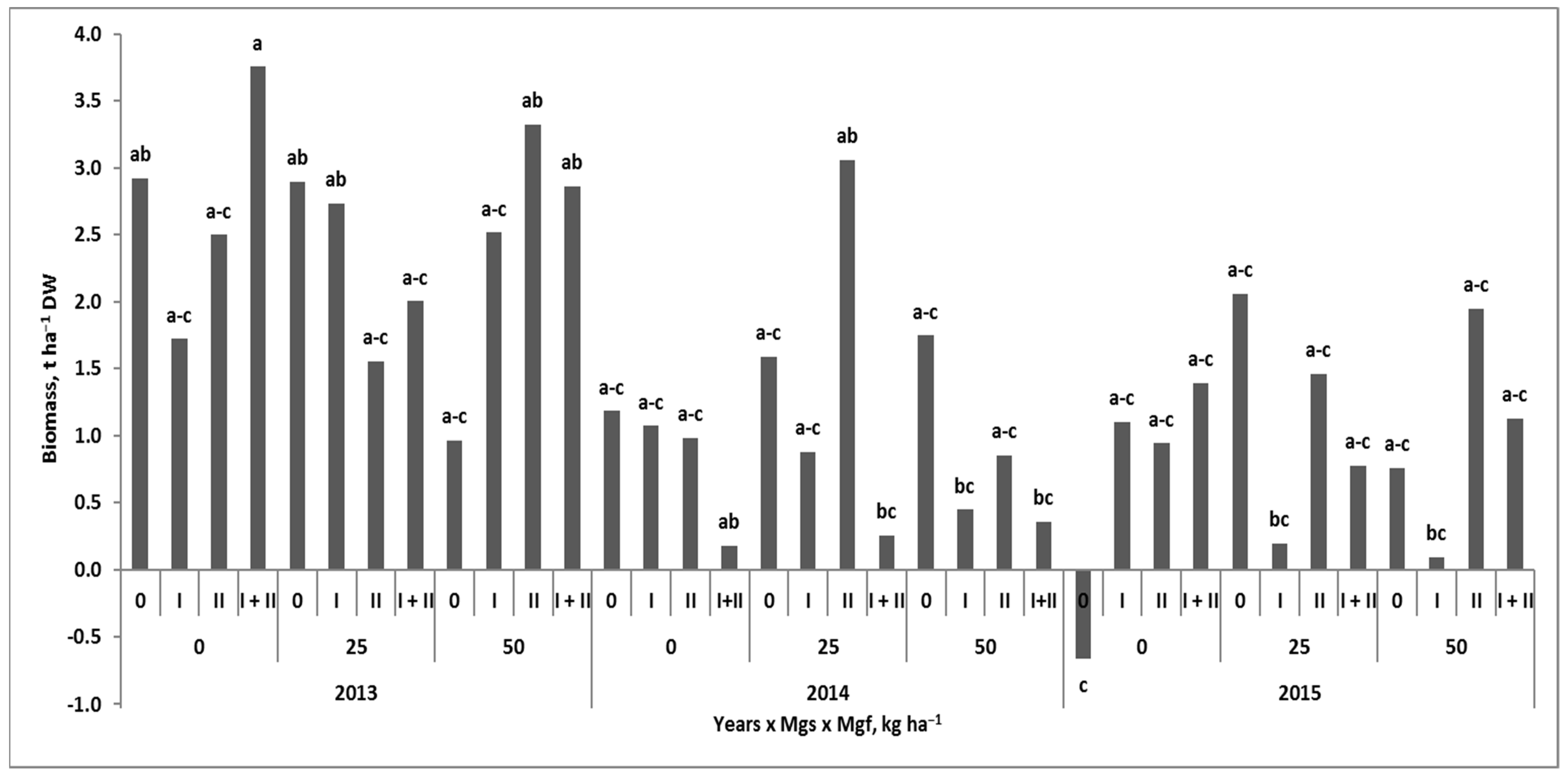
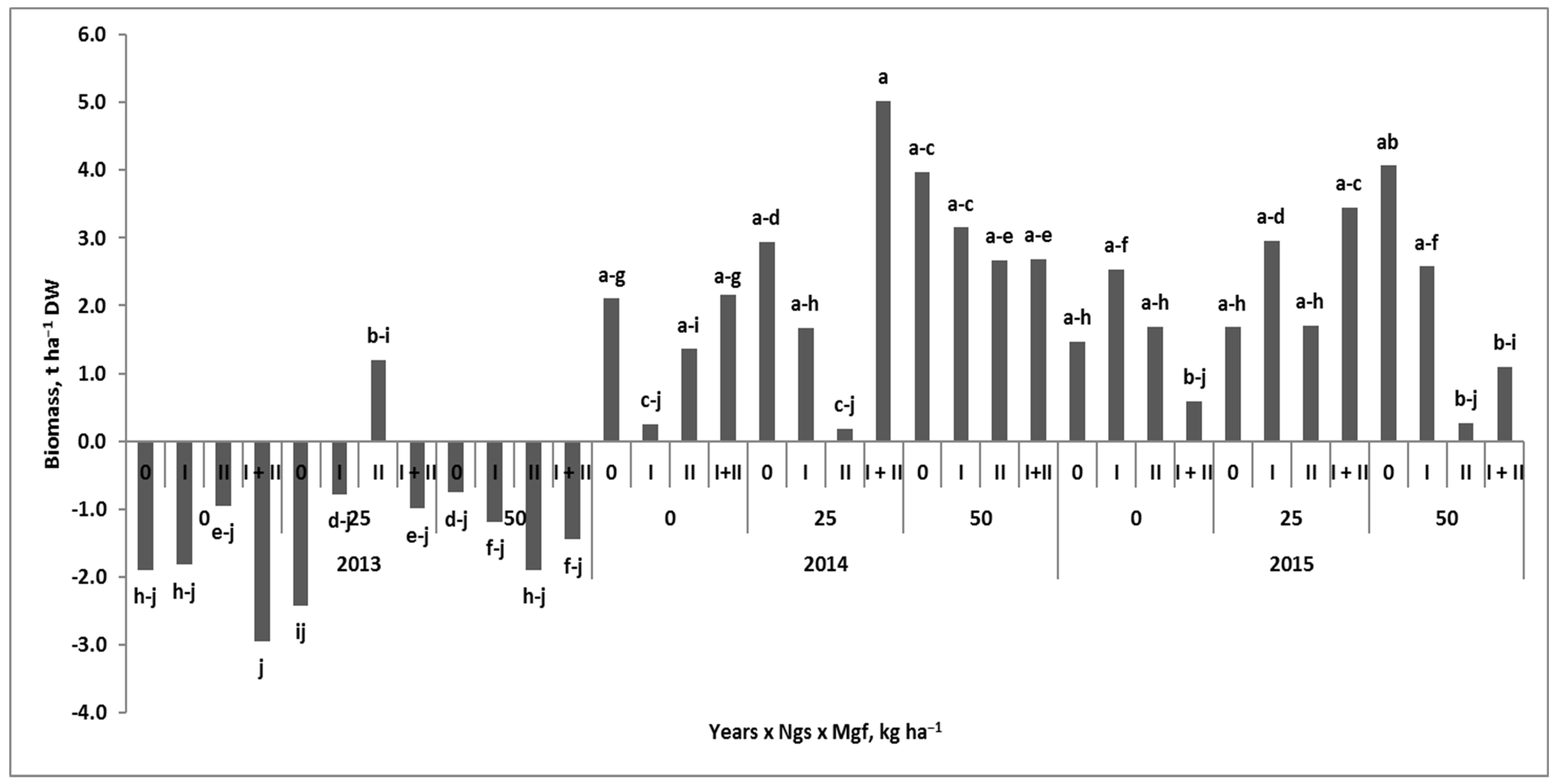
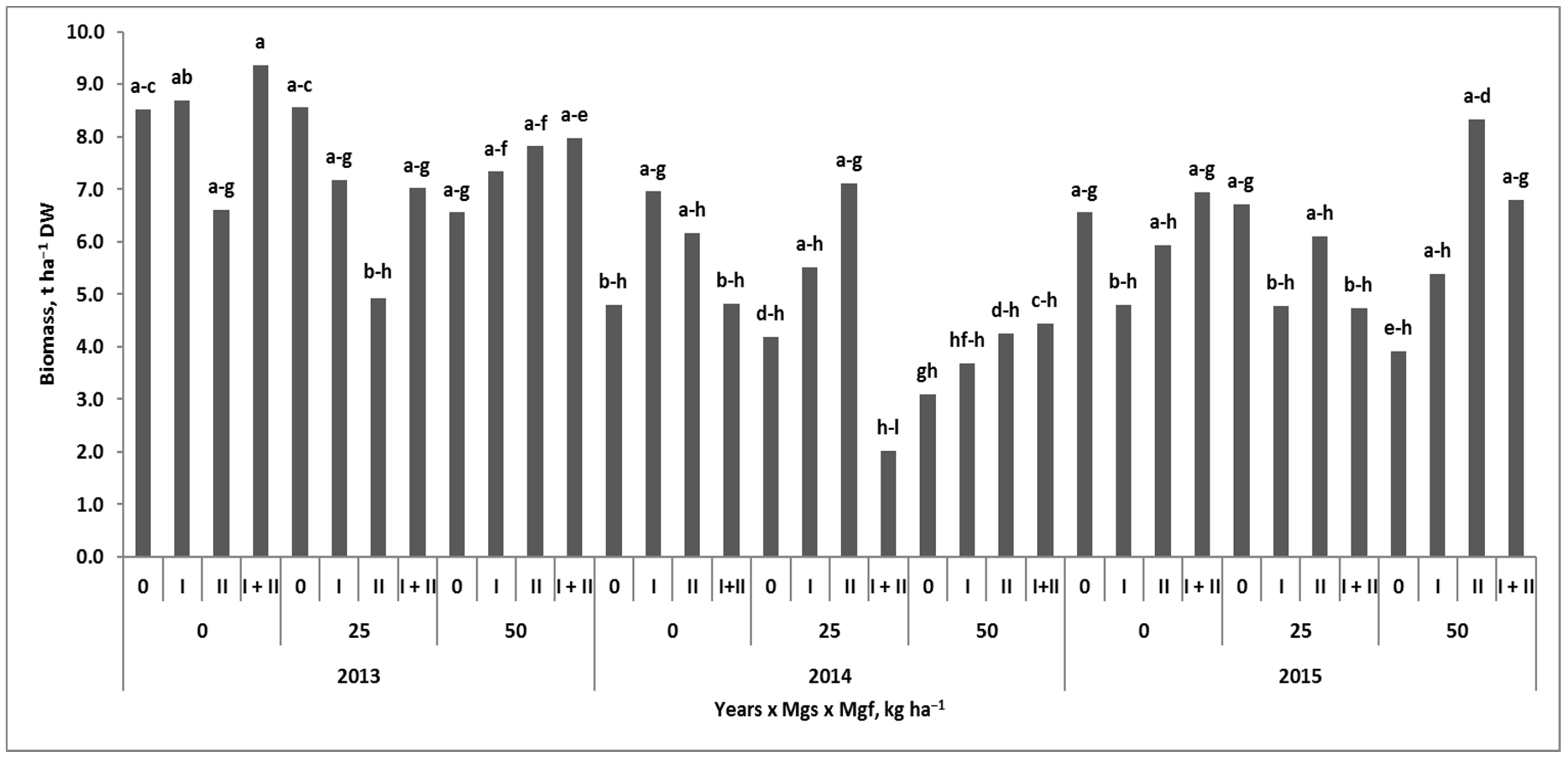

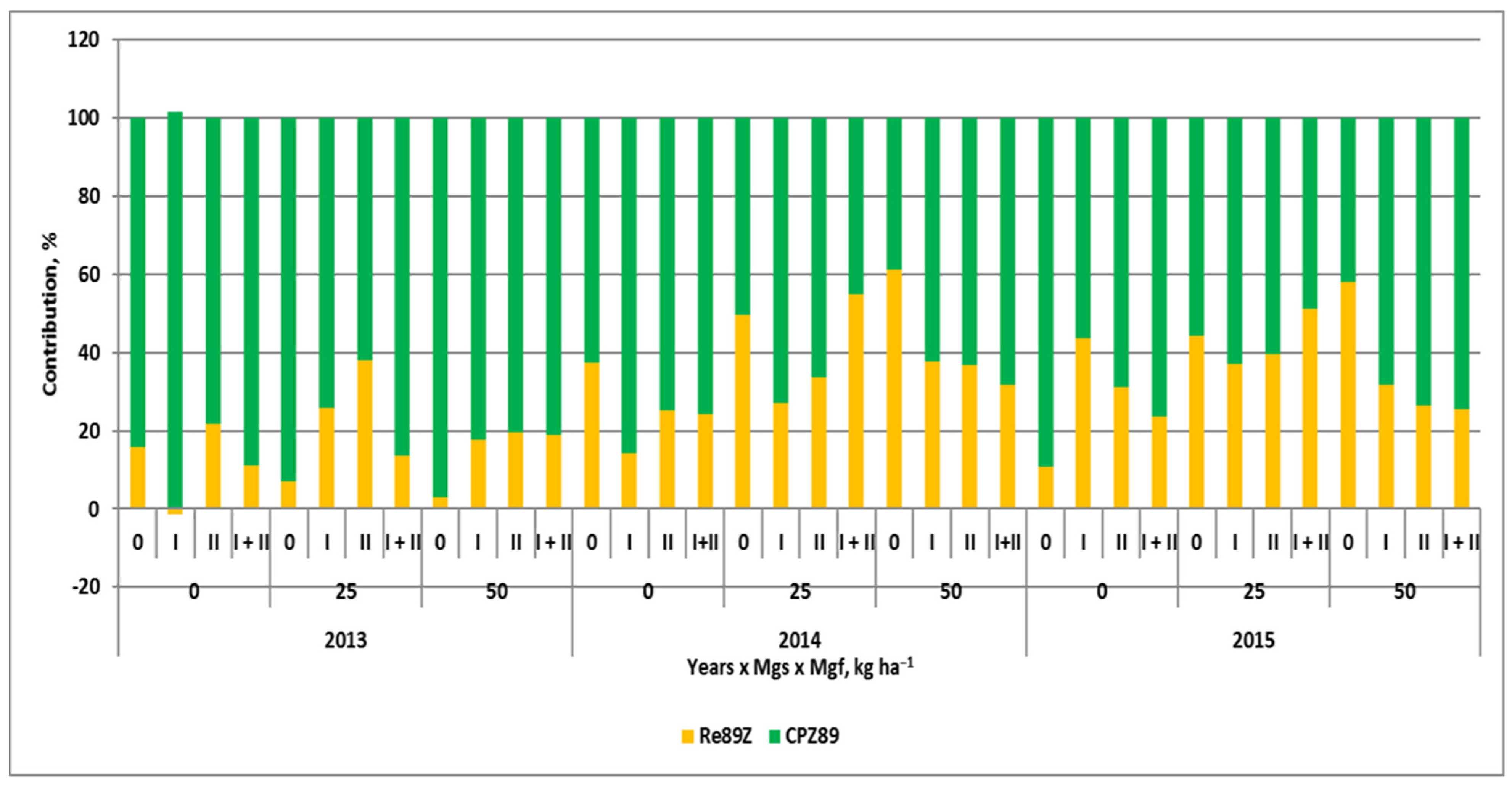
| Year | Soil Layer | pH | P 1 | K 1 | Mg 2 | Nmin |
|---|---|---|---|---|---|---|
| (cm) | 1 M KCl | mg kg−1 soil | kg ha−1 | |||
| 2012/2013 | 0–30 | 6.5 | 63.2 1 M 3 | 157.7 M | 33.2 H | 76 4 |
| 30–60 | 59.7 1 M | 107.9 M | 25.3 M | |||
| 2013/2014 | 0–30 | 6.7 | 91.6 1 H | 168.0 M | 30.2 M | 74 |
| 30–60 | 91.6 1 H | 153.6 M | 24.7 M | |||
| 2014/2015 | 0–30 | 6.6 | 87.2 1 H | 182.6 H | 24.1 M | 57 |
| 30–60 | 95.9 1 H | 149.9 M | 30.2 M | |||
| Treatment | Fertilization Schedule | N–P2O5–K2O | Mg—Soil | Mg—Foliar |
|---|---|---|---|---|
| kg ha−1 | ||||
| 1.1 | NPK | 190-70-80 | 0 | 0 |
| 2.1 | NPK—Mg foliar BBCH 30 | 190-70-80 | 0 | 2.4 |
| 2.2 | NPK—Mg foliar BBCH 49/50 | 190-70-80 | 0 | 4.0 |
| 2.3 | NPK—Mg foliar BBCH 30 + 49.50 | 190-70-80 | 0 | 6.4 |
| 3.1 | NPK—Mg soil | 190-70-80 | 25 | 0 |
| 3.2 | NPK—Mg soil + foliar BBCH 30 | 190-70-80 | 25 | 2.4 |
| 3.3 | NPK—Mg soil + foliar BBCH 49/50 | 190-70-80 | 25 | 4.0 |
| 3.4 | NPK—Mg soil + foliar BBCH 30 + 49/50 | 190-70-80 | 25 | 6.4 |
| 4.1 | NPK—Mg soil | 190-70-80 | 50 | 0 |
| 4.2 | NPK—Mg soil + foliar BBCH 30 | 190-70-80 | 50 | 2.4 |
| 4.3 | NPK—Mg soil + foliar BBCH 49/50 | 190-70-80 | 50 | 4.0 |
| 4.4 | NPK—Mg soil + foliar BBCH 30 + 49/50 | 190-70-80 | 50 | 6.4 |
| Factor | Level of Factor | GY 2 | ED | GR | GD | TGW |
|---|---|---|---|---|---|---|
| t ha−1 | No. m−2 | No. ear−1 | No. m−2 | g | ||
| Year (Y) | 2013 | 8.459 c | 496.6 c | 36.4 b | 18,073 c | 51.4 a |
| 2014 | 10.934 a | 639.9 b | 43.2 a | 27,668 a | 45.8 b | |
| 2015 | 9.689 b | 684.2 a | 31.5 c | 21,554 b | 45.9 b | |
| P | *** | *** | *** | *** | ||
| Mg soil (MgS) kg ha−1 | 0 | 9.536 b | 606.7 ab | 35.8 b | 21,676 c | 47.7 |
| 25 | 9.716 a | 595.9 b | 37.6 a | 22,438 ab | 47.9 | |
| 50 | 9.830 a | 618.1 a | 37.8 a | 23,181 a | 47.5 | |
| P | *** | *** | ** | n.s. | n.s. | |
| Mg foliar 1 (MgF) terms | 0 | 9.428 b | 595.3 b | 36.1 c | 21,374 c | 47.2 b |
| I | 9.793 a | 624.5 a | 37.2 b | 23,094 ab | 47.4 ab | |
| II | 9.713 a | 597.3 b | 36.9 bc | 21,976 bc | 48.1 a | |
| I + II | 9.842 a | 610.4 ab | 38.1 a | 23,283 a | 48.1 a | |
| P | *** | * | *** | *** | ** | |
| Source of variation for interactions | ||||||
| Y × MgS | n.s. | ** | *** | n.s. | n.s. | |
| Y × MgF | n.s. | ** | *** | n.s. | n.s. | |
| MgS × MgF | * | n.s. | n.s. | * | n.s. | |
| Y × MgS × MgF | n.s. | ** | n.s. | n.s. | n.s. | |
| Factor | Level of Factor | LE58 | ST58 | EA58 | T58 | LE79 | ST79 | CH79 | GY79 | T79 | LE89 | ST89 | CH89 | GY89 | dGY | T89 |
|---|---|---|---|---|---|---|---|---|---|---|---|---|---|---|---|---|
| t ha−1 DW | ||||||||||||||||
| Year (Y) | 2013 | 1.35 c | 5.27 c | 2.36 c | 8.99 b | 1.37 b | 6.52 a | 2.42 b | 6.22 c | 16.54 c | 1.01 c | 4.33 c | 2.49 b | 7.27 c | 1.05 b | 15.11 c |
| 2014 | 2.40 a | 7.41 a | 3.15 b | 12.97 a | 2.10 a | 5.73 b | 2.79 a | 7.10 b | 17.73 b | 1.64 b | 5.16 b | 2.78 a | 9.40 a | 2.30 a | 18.98 a | |
| 2015 | 2.04 b | 6.97 b | 3.88 a | 12.88 a | 2.00 a | 6.66 a | 2.22 c | 7.92 a | 18.80 a | 1.67 a | 6.19 a | 2.09 c | 8.33 b | 0.41 c | 18.28 b | |
| P | *** | *** | *** | *** | *** | *** | *** | *** | *** | *** | *** | *** | *** | *** | *** | |
| Mg soil (MgS) kg ha−1 | 0 | 1.79 b | 6.26 b | 2.80 b | 10.85 b | 1.81 | 6.23 | 2.43 | 7.06 | 17.53 | 1.41 | 5.24 ab | 2.40 | 8.20 a | 1.14 | 17.25 b |
| 25 | 2.04 a | 6.68 a | 3.28 a | 12.00 a | 1.79 | 6.34 | 2.48 | 7.12 | 17.74 | 1.46 | 5.09 b | 2.44 | 8.36 b | 1.23 | 17.35 b | |
| 50 | 1.96 a | 6.71 a | 3.32 a | 11.99 a | 1.86 | 6.34 | 2.52 | 7.07 | 17.79 | 1.45 | 5.35 a | 2.52 | 8.45 b | 1.39 | 17.77 a | |
| P | *** | *** | *** | *** | n.s. | n.s. | n.s. | n.s. | n.s. | n.s. | * | n.s. | *** | n.s. | ** | |
| Mg foliar (MgF) | 0 | 1.88 b | 6.57 | 3.11 | 11.56 | 1.71 b | 6.15 | 2.46 | 7.12 | 17.44 | 1.40 | 5.07 | 2.36 | 8.11 b | 0.99 b | 16.94 b |
| I | 1.93 ab | 6.50 | 3.04 | 11.48 | 1.76 b | 6.25 | 2.42 | 7.08 | 17.51 | 1.44 | 5.27 | 2.53 | 8.42 a | 1.35 a | 17.67 a | |
| II | 1.90 ab | 6.47 | 3.30 | 11.67 | 1.97 a | 6.51 | 2.50 | 7.06 | 18.04 | 1.43 | 5.27 | 2.43 | 8.35 a | 1.30 ab | 17.49 a | |
| I + II | 2.01 a | 6.66 | 3.07 | 11.74 | 1.85 ab | 6.30 | 2.52 | 7.08 | 17.76 | 1.48 | 5.29 | 2.49 | 8.46 ba | 1.38 a | 17.73 a | |
| P | * | n.s. | n.s. | n.s. | *** | n.s. | n.s. | n.s. | n.s | n.s. | n.s. | n.s. | *** | ** | *** | |
| Source of variation for interactions between factors | ||||||||||||||||
| Y × MgS | * | *** | n.s. | n.s. | ** | n.s. | n.s | *** | n.s. | n.s | n.s | n.s. | n.s. | ** | n.s. | |
| Y × MgF | *** | * | n.s | * | *** | * | n.s. | ** | ** | *** | n.s. | n.s. | n.s. | * | ** | |
| MgS × MgF | * | n.s. | n.s. | n.s. | n.s. | * | * | n.s. | * | n.s. | *** | n.s. | * | n.s | n.s. | |
| Y × MgS × MgF | ** | ** | ** | *** | n.s. | ** | * | ** | n.s. | ** | n.s. | n.s. | n.s. | * | n.s. | |
| Factor | Level of Factor | Tv79 | Tv89 | REQ89 | RE89 | ReG89 | CP89 | CPC89 | CPG89 |
|---|---|---|---|---|---|---|---|---|---|
| t ha−1 | % | t ha−1 | % | ||||||
| Year | 2013 | 10.3 b | 7.8 c | 1.2 b | 11.8 b | 15.9 b | 6.1 a | 70.1 a | 84.1 a |
| (Y) | 2014 | 10.6 ab | 9.6 b | 3.4 a | 25.4 a | 36.1 a | 6.0 ab | 47.9 b | 63.9 b |
| 2015 | 10.9 a | 9.9 a | 2.9 a | 21.9 a | 35.3 a | 5.4 b | 43,4 b | 64.7 b | |
| P | * | *** | *** | *** | *** | * | *** | *** | |
| Mg soil | 0 | 10.5 | 9.1 | 1.8 b | 15.2 b | 21.5 b | 6.4 a | 61.7 a | 78.5 a |
| (MgS) | 25 | 10.6 | 9.0 | 3.0 a | 23.3 a | 35.2 a | 5.4 b | 48.1 b | 64.8 b |
| kg ha−1 | 50 | 10.7 | 9.3 | 2.7 a | 20.6 a | 30.6 a | 5.8 b | 51.6 b | 69.4 b |
| P | ns | ns | *** | *** | *** | *** | *** | *** | |
| Mg foliar1 | 0 | 10.3 b | 8.8 b | 2.7 | 20.7 | 31.9 | 5.4 | 51.7 | 68.1 |
| (MgF) | I | 10.4 ab | 9.2 a | 2.2 | 17.6 | 25.9 | 6.2 | 57.5 | 74.1 |
| II | 11.0 a | 9.1 a | 2.5 | 21.1 | 30.2 | 5.8 | 51.5 | 69.8 | |
| I + II | 10.7 ab | 9.3 a | 2.5 | 19.3 | 28.4 | 6.0 | 54.7 | 71.6 | |
| P | * | * | ns | ns | ns | ns | ns | ns | |
| Source of variation for interactions between factors | |||||||||
| Y × MgS | ns | ns | ns | ns | ns | ns | ns | ns | |
| Y × MgF | * | ** | ** | ** | ** | ** | ** | ** | |
| MgS × MgF | * | ns | ns | ns | ns | ns | ns | ns | |
| Y × MgS × MgF | ns | ns | ** | ** | ** | * | ** | ** | |
| Factor | Level of Factor | REQ d79 | RE d79 | ReE d79 | CPd d79 | CPE d79 | CPG d79 | REQ d89 | RE d89 | ReG d89 | CP d89 | CPE d89 | CPG d89 |
|---|---|---|---|---|---|---|---|---|---|---|---|---|---|
| t ha−1 | % | t ha−1 | % | t ha−1 | % | t ha−1 | % | ||||||
| Year (Y) | 2013 | −1.32 a | −15.9 a | −21.0 a | 7.55 c | 45.3 a | 121.0 b | 2.48 b | 14.5 b | 117.1 b | −1.42 a | −9.68 a | −77.1 a |
| 2014 | 2.35 b | 17.0 b | 33.4 b | 4.76 a | 26.3 a | 66.5 a | 1.05 a | 5.6 a | 50.2 a | 1.25 c | 6.39 c | 49.8 b | |
| 2015 | 2.01 b | 14.9 b | 25.8 b | 5.92 b | 31.2 b | 74.2 a | 0.93 a | 4.59 a | 301.3 a | −0.52 b | −2.92 b | −201.3 b | |
| P | *** | *** | *** | *** | *** | *** | *** | *** | *** | *** | *** | n.s. | |
| Mg soil (MgS) kg ha−1 | 0 | 0.38 a | 0.6 a | 4.1 a | 6.68 b | 37.07 b | 95.9 b | 1.42 | 7.98 | 56.5 | −0.28 | −2.66 | 43.5 |
| 25 | 1.38 b | 8.3 b | 17.9 b | 5.74 a | 32.29 a | 82.1 a | 1.62 | 8.95 | 57.8 | −0.39 | −2.77 | 42.2 | |
| 50 | 1.27 b | 7.2 b | 16.4 b | 5.80 a | 32.44 a | 83.6 a | 1.42 | 7.79 | 414.3 | −0.03 | −0.79 | −314.3 | |
| P | *** | ** | ** | * | *** | ** | n.s. | n.s. | n.s. | n.s. | n.s. | n.s. | |
| Mg foliar 1 (MgF) | 0 | 1.24 | 6.5 | 15.4 | 5.88 | 33.8 | 84.6 | 1.49 | 8.32 | −97.3 | −0.50 | −3.50 | 197.3 |
| I | 1.04 | 5.9 | 13.7 | 6.04 | 34.4 | 86.3 | 1.19 | 6.74 | 17.3 | 0.15 | 0.10 | 82.7 | |
| II | 0.69 | 4.2 | 8.7 | 6.36 | 35.2 | 91.3 | 1.85 | 10.13 | 467.5 | −0.55 | −3.61 | −367.5 | |
| I + II | 1.07 | 4.8 | 13.5 | 6.02 | 33.7 | 86.5 | 1.41 | 7.77 | 317.3 | −0.03 | −1.26 | −217.3 | |
| P | n.s. | n.s. | n.s. | n.s. | n.s. | n.s. | n.s. | n.s. | n.s. | * | n.s. | n.s. | |
| Source of variation for interactions between factors | |||||||||||||
| Y × MgS | ns | ns | ns | ns | ns | ns | ns | ns | ns | ns | ns | ns | |
| Y × MgF | *** | *** | *** | *** | *** | *** | ns | ns | ns | ns | ns | ns | |
| MgS × MgF | *** | *** | *** | ** | *** | *** | ns | ns | ns | ns | ns | ns | |
| Y × MgS × MgF | * | * | * | ns | * | * | * | ** | ns | ns | * | ns | |
Publisher’s Note: MDPI stays neutral with regard to jurisdictional claims in published maps and institutional affiliations. |
© 2021 by the authors. Licensee MDPI, Basel, Switzerland. This article is an open access article distributed under the terms and conditions of the Creative Commons Attribution (CC BY) license (https://creativecommons.org/licenses/by/4.0/).
Share and Cite
Grzebisz, W.; Potarzycki, J. Effect of Magnesium Fertilization Systems on Grain Yield Formation by Winter Wheat (Triticum aestivum L.) during the Grain-Filling Period. Agronomy 2022, 12, 12. https://doi.org/10.3390/agronomy12010012
Grzebisz W, Potarzycki J. Effect of Magnesium Fertilization Systems on Grain Yield Formation by Winter Wheat (Triticum aestivum L.) during the Grain-Filling Period. Agronomy. 2022; 12(1):12. https://doi.org/10.3390/agronomy12010012
Chicago/Turabian StyleGrzebisz, Witold, and Jarosław Potarzycki. 2022. "Effect of Magnesium Fertilization Systems on Grain Yield Formation by Winter Wheat (Triticum aestivum L.) during the Grain-Filling Period" Agronomy 12, no. 1: 12. https://doi.org/10.3390/agronomy12010012
APA StyleGrzebisz, W., & Potarzycki, J. (2022). Effect of Magnesium Fertilization Systems on Grain Yield Formation by Winter Wheat (Triticum aestivum L.) during the Grain-Filling Period. Agronomy, 12(1), 12. https://doi.org/10.3390/agronomy12010012







